

International
Labour Organization
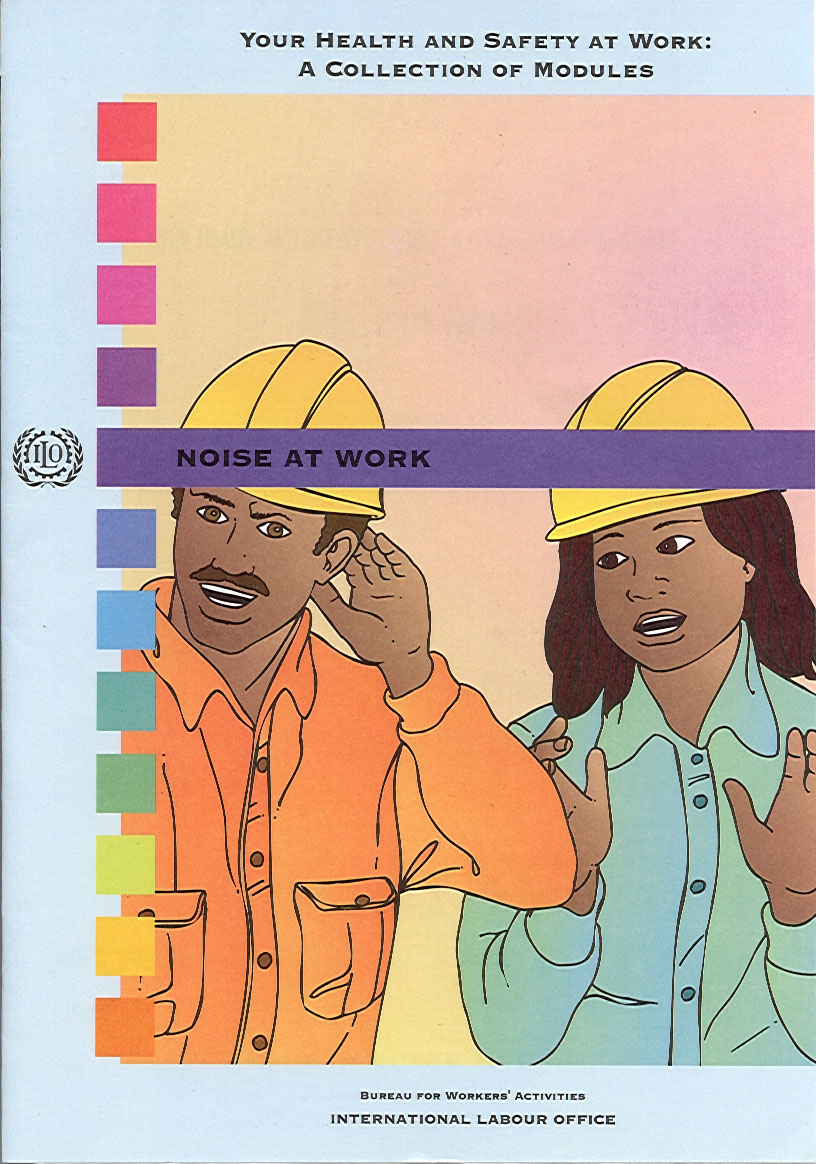 Your health and safety at work
Your health and safety at work
NOISE AT WORK
Goal of the Module
This Module provides trainees with background information on how occupational noise exposure can affect a worker's health and safety. Topics discussed include: the health effects of exposure to noise, how to measure noise, methods of noise control, and the role of the health and safety representative in controlling occupational noise.
Objectives
 |
At the end of this Module trainees will be able to: (1) give several examples of how occupational noise can affect a worker; (2) suggest several methods of noise control in the workplace; (3) identify several potential noise hazards in the workplace. |
What is in this module
 |
I. Introduction
V. Role of the health and safety representative |
Not all sound is noise — noise is sound that people do not like. Noise can be annoying and it can interfere with your ability to work by causing stress and disturbing your concentration. Noise can cause accidents by interfering with communication and warning signals. Noise can cause chronic health problems. Noise can also cause you to lose your hearing.

Hearing loss from exposure to noise in the workplace is one of the most common of all industrial diseases. Workers can be exposed to high noise levels in workplaces as varied as construction industries, foundries and textile industries. Short-term exposure to excessive (too much) noise can cause temporary hearing loss, lasting from a few seconds to a few days. Exposure to noise over a long period of time can cause permanent hearing loss. Hearing loss that occurs over time is not always easy to recognize and unfortunately, most workers do not realize they are going deaf until their hearing is permanently damaged. Industrial noise exposure can be controlled — often for minimal costs and without technical difficulty. The goal in controlling industrial noise is to eliminate or reduce the noise at the source producing it.
 |
|
|
|
II. Health effects of noise exposure
What are the health effects of exposure to too much noise?
The health effects of noise exposure depend on the level of the noise and the length of the exposure.
After spending a short time in a noisy workplace, you may have noticed that you cannot hear very well and you have a ringing in your ears. This condition is called temporary threshold shift. The ringing and the feeling of deafness normally wear off after you have been away from the noise for a short time. However, the longer you are exposed to the noise, the longer it takes for your hearing to return to “normal”. After leaving work, it may take several hours for a worker's ears to recover. This may cause social problems because the worker may find it difficult to hear what other people are saying or may want the radio or television on louder than the rest of the family.
Suspect hearing loss if a person complains that he or she cannot hear something when you can. |
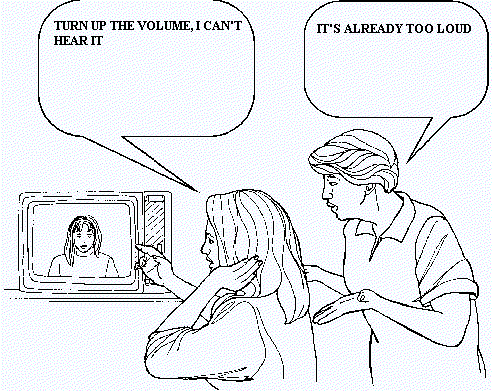 |
Eventually, after you have been exposed to excessive noise for too long, your ears do not recover and the hearing loss becomes permanent. Permanent hearing loss can never be repaired. This type of damage to the ear can be caused by long-term exposure to loud noise or, in some cases, by short exposures to very loud noises.
When a worker begins to lose his or her hearing, he or she may first notice that normal talking or other sounds, such as warning signals, are becoming unclear. Workers often adapt themselves (“get used to”) to hearing loss produced by harmful noises at work. For example, they may begin to read lips as people talk, but have difficulty listening to someone in a crowd or on the telephone. In order to hear the radio or television they may need to turn up the volume so much that it deafens the rest of the family. “Getting used to” noise means you are slowly losing your hearing.
It is important for you and your co-workers to be aware of signs of hearing loss. |
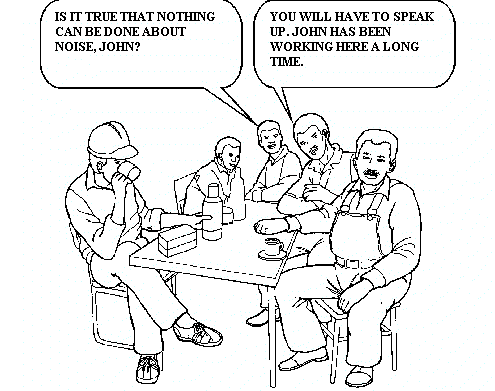 |
Hearing tests are the only reliable way to find out whether a worker is suffering from hearing loss. Unfortunately, hearing tests can be difficult to obtain and need to be performed by a trained health-care professional. The reactions of new workers or visitors to a noisy workplace can be indicators of a noise problem, for example if they have to shout, cover their ears, or leave “in a hurry”.
In addition to hearing loss, exposure to noise in the workplace can cause a variety of other problems, including chronic health problems:
Masking noise |
 |
 |
|
|
|
Noise in the workplace may be disturbing because of its frequency as well as its volume. For example, a high-pitched noise, such as a whistle, irritates the ears much more than a noise with a low pitch, even if the volume is the same in both cases.
Sounds have different intensities (loudness). For example, if you shout at someone instead of whispering, your voice has more energy and can travel a great distance, therefore it has more intensity (loudness). Intensity is measured in units which are calls decibels (dB) or dB(A). The decibel scale is not a typical scale — it is a logarithmic scale. Basically this means that a small increase in the decibel level is, in reality, a big increase in the noise level.
For example, if sound is increased by 3 dB at any level, your ears will tell you that the sound has approximately doubled in volume. Similarly, if sound is reduced by 3 dB, your ears will feel that the volume has been cut in half. Therefore, an increase of 3 dB from 90 dB to 93 dB means the volume of the noise has doubled. However, a 10 dB increase at any level (for example, from 80 dB to 90 dB) means the noise intensity has increased ten times.
Inside a typical workplace, noise comes from different sources, such as tools (machinery and materials handling), compressors, background noise, etc. If you want to identify all of the noise problems in the workplace, then you must measure the noise from each source separately. For example, if two different sources of noise in a workplace each create 80 dB by themselves, the level of noise they make together is 83 dB (not 160 dB). Therefore when you consider the amount of noise the two sources make together, the level of noise has doubled.
An effective way to measure the noise in your workplace is with a sound meter. Unfortunately, it can be difficult to get the meters and the trained personnel to use them. However, there is a simple method that will help you to understand if there is a noise problem in your workplace:
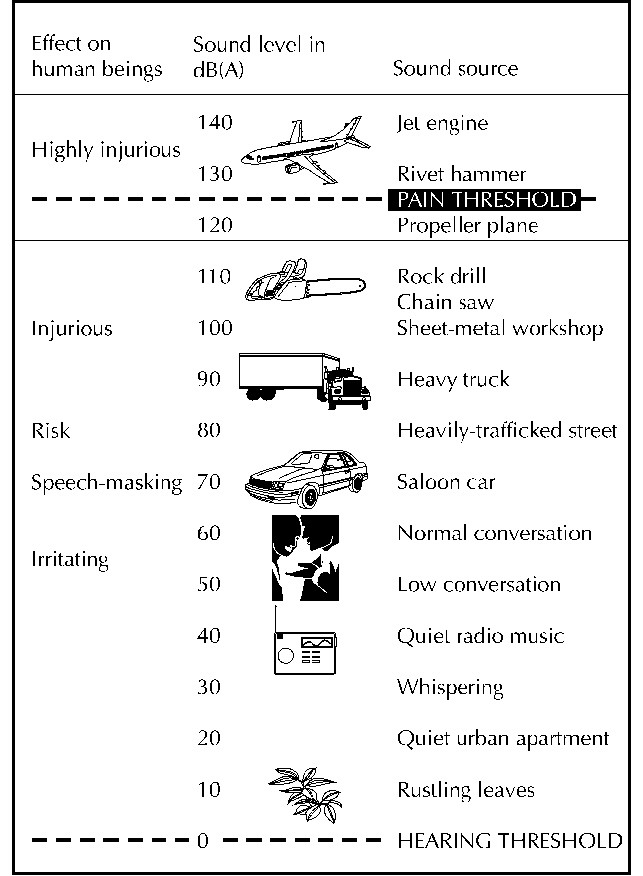
Simple method for assessing noise exposure Stand at arm's length from a co-worker. If you cannot speak in a normal tone and have to shout to communicate, then the noise level in your workplace is too high and should be reduced! |

Is there a safe level of noise?
A safe level of noise basically depends on two things: (1) the level (volume) of the noise; and (2) how long you are exposed to the noise. The level of noise allowed by most countries' noise standards is generally 85-90 dB over an eight-hour workday (although some countries recommend that noise levels be even lower than this).
Exposure to higher noise levels may be allowed for periods of less than eight hours of exposure time. For example, workers should not be exposed to noise levels above 95 dB for more than four hours per day. Exposed workers should be provided with ear protection while exposed at this level and rotated out of the noise areas after four hours of continuous work. Of course before using ear protection and rotation every effort should be made to reduce noise using engineering controls.
The eight-hour per day exposure limit found in a noise standard is the total amount of noise that a worker may be exposed to over an eight-hour period. The exposure may be from continuous (constant) noise, or from intermittent noise (noise that is periodic at regular intervals but not continuous). Therefore, you must add up the levels of noise you are exposed to throughout the day and see if they exceed 85-90 dB. Note: workers should never be exposed to more than 140 dB of impulse noise (usually a very loud noise that occurs only once) at any time.
The following chart gives recommended limits of noise exposure for the number of hours exposed.
| No. of hours exposed | Sound level dB |
| 8 | 90 |
| 6 | 92 |
| 4 | 95 |
| 3 | 97 |
| 2 | 100 |
| 1.5 | 102 |
| 1 | 105 |
| 0.5 | 110 |
| 0.25 or less | 115 |
 |
|
|
|
How can noise be controlled?
Workplace noise can be controlled: (1) at the source; (2) through the use of barriers; and (3) at the worker.
As with other types of exposures, the best method of prevention is to eliminate the hazard. Therefore controlling noise at its source is the best method of noise control. It can also often be cheaper than other methods of noise control. This method of control may require that some noisy machinery be replaced. Noise can be controlled at the source by the manufacturer, so that noisy devices never reach your workplace. Many machines are now required to conform to noise standards. Therefore before new machines (such as presses, drills, etc.) are purchased, checks should be made to see that they conform to noise standards. Unfortunately, many used machines producing high noise levels (which have been replaced with quieter models) are often exported to developing countries, causing workers to pay the price with hearing loss, stress, etc.
Put a silencer on the machine instead of ear protectors on the workers. |
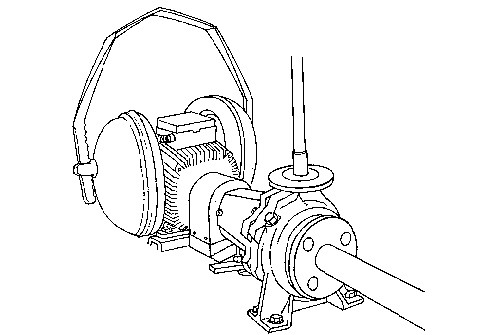 |
Noise control at the source can also be engineered into an existing device by making adjustments to parts or a whole machine that reduce noise. For example, the noise level from a pneumatic drill can be reduced by placing a sound-reducing blanket around the drill. A length of tubing on the exhaust of the drill will also reduce the noise level. A rubber covering can be used to reduce noise from metal falling on to metal.
Other engineering methods to reduce noise include:
Noise - insulated air compressors. The principle is that the noise should be contained under the hood. The hood is made of hard material with a soft, absorbent lining. |
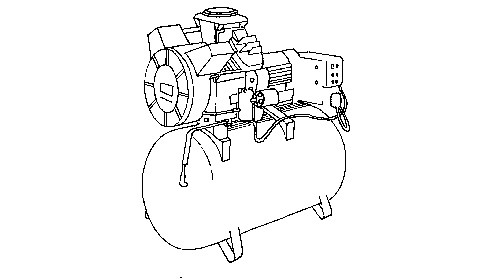 |
1.5 mm stiffened plate reduces vibrations. |
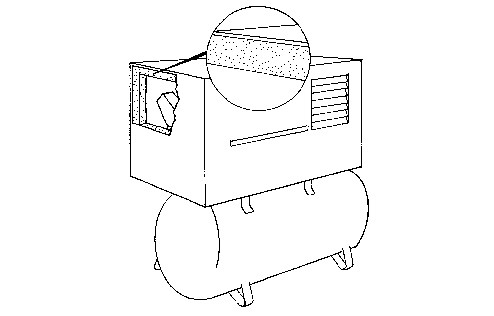 |
Regular maintenance, lubrication and replacement of worn or defective parts can also be effective ways to reduce noise levels. Noise from the way materials are handled can be reduced by measures such as:
A machine vibrating on a hard floor is a common source of noise. Mounting vibrating machines on rubber mats or other damping material will reduce the noise problem.
If it is not possible to control the noise at the source, then it may be necessary to enclose the machine, place sound-reducing barriers between the source and the worker, or increase the distance between the worker and the source. (However, this can be difficult in many cases.) The following chart is a simple method of knowing how much sound is reduced by distance.
If a small sound source produces a sound level of 90 dB at a distance of 1 meter, the sound level at a 2-meter distance is 84 dB, at 4 meters 78 dB, etc. |
 |
Here are a few points to remember when controlling noise with barriers:
Controlling noise at the worker, by using ear protection (sometimes called hearing protection) is, unfortunately, the most common yet least effective form of noise control. Forcing the worker to adapt to the workplace is always the least desirable form of protection from any hazard. Generally there are two types of ear protection: earplugs and earmuffs. Both are designed to prevent excessive noise from reaching the inner ear.
Earplugs are worn inside the ear and come in a variety of materials, including rubber, plastic, or any material that will fit tightly in the ear. Earplugs are the least desirable type of hearing protection because they do not provide very effective protection against noise and they can cause ear infection if pieces of the plug are left in the ear or if a dirty plug is used. Cotton wool should not be used as ear protection.
Earplugs and earmuffs: |
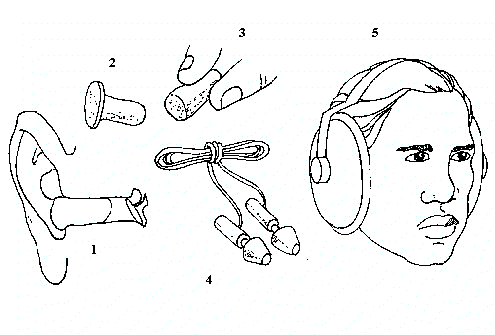 |
Earmuffs are more protective than earplugs if they are used correctly. They are worn over the whole ear and protect the ear from noise. Earmuffs are less efficient if they do not fit tightly or if glasses are worn with them.
Ear protection is the least acceptable method of controlling an occupational noise problem because:
 |
|
|
|
V. Role of the health and safety representative
Health and safety representative |
 |
Your role is to work proactively (this means taking action before there are health or hearing problems) to eliminate or control occupational noise exposure. Controlling noise will help to protect workers' hearing as well as their overall health. Use the Check-list for controlling occupational noise at the end of this Module to help you assess noise controls in your workplace. Other steps to help you reach your goals are:
Watch for early signs indicating hearing loss. Educate your co-workers so that they also can look for warning signs.
Work with your union and the employer to get the noise levels in your workplace measured. Noise monitoring is an effective way to find out the precise levels of noise and the sources of noise in the workplace. (Unfortunately, a sound meter and the trained personnel to use it can be difficult to get. Your local factory inspectorate may be able to measure the noise at your workplace.)
Try to obtain any results of the noise monitoring and compare the results with your country's noise standards (if they exist).
If your country does not have a noise standard then try to work with your employer to reach the lowest possible decibel level in the workplace. Work with your union to put pressure on your government to develop a noise standard.
Conduct the simple method for assessing noise exposure: Stand at arm's length from a co-worker. If you cannot speak in a normal tone and have to shout to communicate, then the noise level in your workplace is too high and should be reduced.
Work with the union and the employer to eliminate noise hazards.
Where noise cannot be eliminated, work with the union and the employer to engineer noise reduction at the source. This may be cheaper than buying ear protectors for everyone. If source reduction is not possible, then barriers should be used. Workers exposed to noise levels of 95 dB should wear ear protectors and be rotated after no more than four hours of continuous work at this noise level. (It is important to make sure employers do not expose workers to noise levels of 95 dB for more than four hours per day.)
Providing workers with ear protection is the least acceptable method of noise control. However, if this is the only solution, then earmuffs are a better choice than earplugs. Try to read the packages of various types of ear protectors to find out the level of protection they will provide. Discuss this information with your employer before he or she purchases the ear protectors. Workers should be trained in the proper use of, and the importance of wearing, their ear protectors. Try to get agreement from the employer to eliminate noisy machinery by a specified date.
If possible, have extra ear protectors available in the workplace to protect workers in case they forget or lose their own ear protectors.
Areas where ear protectors must be worn should be marked clearly, using symbols showing the need for ear protectors. For these areas, try to develop non-verbal ways of communicating so workers can still receive warning signals in case of danger.
Pay attention to new workers or visitors — their responses may indicate that there is a noise problem in your workplace.
Conduct a workplace survey asking your co-workers about problems with noise in their work areas. List the various health problems that can be caused by noise and ask workers if they experience any of these. Information about health problems may help you to identify excessive noise exposures.
If possible, try to have regular hearing tests provided for workers exposed to excessive noise. Some unions have negotiated hearing tests as part of their collective agreements.
 |
|
Exercise. Case-study on occupational noise
 |
Note to the instructor You will need to provide each trainee, or each group of trainees, with a copy of the case - studies. If you cannot make copies, then read the case - studies out loud to the group and discuss. Trainees should work in small groups of three to five people. Instructions Each group should read the cases and then answer the questions. Discuss group answers with the whole group. The following case - studies are based on real situations. Case 1 The problem Company XYZ is a manufacturer with five power presses producing noise levels of 102 - 104 dB. Even when only one or two presses are operating, the noise levels are still as high as 98 dB. This is painful for the workers and puts them in serious danger of losing their hearing. Question (1) What solutions to this problem can you suggest? How the problem was solved To solve the problem, the power presses were moved to a distance of 20 metres from the place where most of the workers were located. In this way, the workers were exposed to acceptable noise levels of 75-80 dB. Workers who operated the power presses were provided with earmuffs and rotated to a quieter section of the factory after a maximum of four hours' continuous work in the power press area. Questions (1) Were these actions good solutions to the problem? Why or why not? (2) Are workers safe if they are exposed to excessive noise for only four hours? (3) Do you think there was still noise exposure for the workers even after the changes were made? (4) Can you think of any better solutions to the problem? (5) Why are earmuffs not an acceptable solution to noise exposure? Case 2 The problem Company ABC produces nails. The machines that cut the nails produce a noise level of 95 dB. These machines are all in a row in one section of the factory and need to be operated by a worker for eight hours a day. All workers have been given ear protectors but they do not wear them because it is too hot and uncomfortable. Question (1) What solutions to this problem can you suggest? How the problem was solved The union and the employer discussed the noise problem and decided that enclosing the nail-cutting machines would cost less than buying ear protectors for all of the workers. Inexpensive, local materials were used to build a full enclosure around the machines. The enclosure reached from the floor to the ceiling, with no holes except the door to enter the machine area. The enclosure reduced the noise level outside the machine area to 85 dB. Workers operating the nail-cutting machines were required to wear earmuffs and were also rotated out of that area after four hours of continuous work there. A sign was placed on the door to the enclosed area reminding workers to put on their earmuffs before entering the noisy area. Questions (1) Were these actions good solutions to the problem? Why or why not? (2) Why were the workers rotated out of the enclosed area after four hours of continuous work there? (3) Can you think of any better solutions to the problem? (4) Are the solutions to this case better than the solutions that were used for the first case? Why or why not? |
Points for discussion
|
Action
plan
for controlling occupational noise in your workplace
Note to the instructor
Give each trainee a copy of the following action plan to use in his or her own workplace.
Action plan
Develop an action plan to help you address any problem(s) with noise in your workplace.
1. Describe the problem.
.....................................................................................................................................
....................................................................................................................................
....................................................................................................................................
....................................................................................................................................
....................................................................................................................................
....................................................................................................................................
2. How can the problem be solved?
....................................................................................................................................
....................................................................................................................................
....................................................................................................................................
....................................................................................................................................
....................................................................................................................................
....................................................................................................................................
3. What steps can your union take to solve the problem?
....................................................................................................................................
....................................................................................................................................
....................................................................................................................................
....................................................................................................................................
....................................................................................................................................
....................................................................................................................................
4. What steps should your employer take to solve the problem?
....................................................................................................................................
....................................................................................................................................
....................................................................................................................................
....................................................................................................................................
....................................................................................................................................
....................................................................................................................................
5. What will you do about this problem when you return to your workplace?
....................................................................................................................................
....................................................................................................................................
....................................................................................................................................
....................................................................................................................................
....................................................................................................................................
....................................................................................................................................
Check-list for controlling occupational noise
 |
Note to the instructor Give each trainee a copy of this check-list to use in his or her own workplace. Relate it to the action plan as far as possible. Instructions for using this check-list Use this workplace check-list as a guide for assessing noise controls in your workplace. |
| YES | NO | |
| 1. Are noisy parts or machines enclosed or covered completely? | ||
| 2. Are machines serviced regularly to avoid increased noise? | ||
| 3. Are sound-absorbing materials used on the ceiling, walls, or machine covers? | ||
| 4. Are noisy equipment and noisy parts replaced with quieter models? | ||
| 5. Are adequate barriers used to prevent noise from spreading? | ||
| 6. Has the dropping height been reduced for goods being collected in bins and boxes? | ||
| 7. Are people working with quieter machines protected from noise produced by other machines? | ||
| 8. Are workers in noisy work areas rotated to avoid long hours of exposure? | ||
| 9. Are earmuffs or earplugs used where the noise level reaches or exceeds 85-90 dB? |